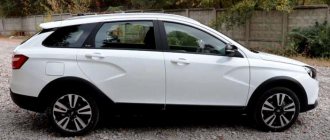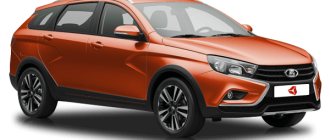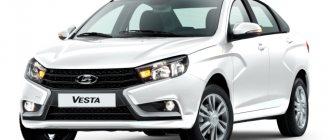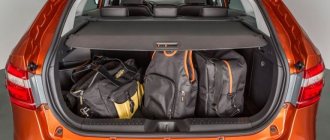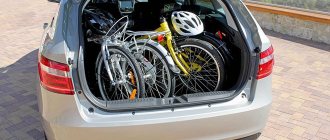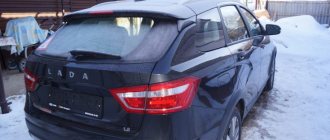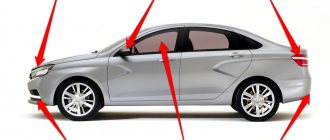Even at the stages of car development, it was known that the Vesta platform would be truly new, and not just another modernization of the VAZ 2108 suspension. Now that serial production of the sedan has already started, and the first samples have already been on test drives in various car magazines, more detailed details are being clarified about the chassis of the Lada Vesta.
The last adjustments to the suspension characteristics took place in winter in Spain, at the IDIADA training ground. Then a balance was found between comfort and car controllability. What happened?
Lada Vesta SV Cross salon photo
Before we start reviewing the interior of the Lada Vesta SV Cross, let's take a look at the photo. This is necessary to have at least the slightest idea of what it is. Also, do not forget that we have an article on our website where we talked about the prices and configurations of the 2022 Lada Vesta Cross station wagon.
Price difference
Station wagon cost:
- Lada Vesta SW from 639,900 to 804,900 rubles.
- Lada Vesta SW Cross from 755,900 to 847,900 rubles.
Having an amount of about 760 thousand rubles, the buyer begins to think about which of the two station wagons is better to buy:
- Lada Vesta SW 1.8L with manual transmission in the Luxe Multimedia package for 761,900 rubles.
- Lada Vesta SW Cross 1.6l with manual transmission in Luxe configuration for 755,900 rubles.
A regular station wagon will have:
- More powerful engine.
- Multimedia system with navigation 7".
- Rear view camera.
A regular station wagon will not have:
- Original body kit.
- Body color "Mars".
- Orange interior trim.
- Exhaust pipe nozzle.
- Increased ground clearance.
- A different suspension (different from the sedan).
- Alloy wheels R17 (will be R16).
Lada Vesta SV Cross 2022 and 2022 salon
The interior of the 2022 and 2022 Vesta SV Cross is no different, since the car was released only at the end of 2022 and has not yet undergone any changes in 2018. So, let's look at the interior of the Lada Vesta SV Cross.
Car front panel
One of the most important elements on the front panel is the steering wheel. This is the so-called multifunctional steering wheel with the ability to control the multimedia system. There is a driver airbag in the steering wheel. In any configuration you will receive a leather-trimmed steering wheel.
Under the steering wheel there are paddle switches that control the car's windshield wipers and lights.
One of the most important parts of the Lada Vesta SV Cross interior is the central panel. Yes, it is made of hard plastic, like its classmates - Kia Rio and Hyundai Solaris. But she doesn’t cause any disgust. Everything is done harmoniously and thoughtfully. The multimedia system display, air conditioning control, and other control keys are conveniently located in the center.
In front of the driver’s eyes is a well-readable instrument panel - speedometer, tachometer, fuel level and temperature gauges. All devices fit well into deep wells and look great at any time of the day.
The passenger sees only the glove box in front of him - the glove compartment, by the way, is very spacious.
In the center of the Lada Vesta SV Cross cabin there is a tunnel with cup holders, a gearbox control knob and an armrest. Depending on the installed gearbox, the handle will have a different appearance. If the car is equipped with a manual transmission, the gearshift knob will look like this:
... if a robot is installed in the car, then you will have to control the box modes with this handle:
Next, traditionally, are the handbrake and armrest, which are quite roomy.
Door trims
The door trims are made of the same plastic as the front panel, but additionally have inserts that fit seamlessly into the rest of the interior design. Door trims combine not only stylish design, but also thoughtful ergonomics. You can easily put a water bottle or other small items in the door. There are ESP buttons on all doors, and on the driver’s side there is a control unit for all ESPs, mirror adjustment, door and lift locking.
Seats, floor, ceiling
floor of the Lada Vesta SV Cross is a classic carpet, like on 80% of budget foreign cars. Not very durable, but it serves its purpose, and nothing more is required from it. Mats - rubber or textile - protect the carpet from moisture and dirt.
Seats. Here's a little more detail. In the Lada Vesta SV Cross station wagon, the most thoughtful detail is the seats. They are the only ones with no questions in terms of comfort and design. Yes, it is comfortable to sit on such chairs. You can travel long distances and not worry about back and lower back pain. Externally, there is also nothing to blame the designers for. The seats look fresh and modern.
The ceiling in the Lada Vesta interior has a normal high-quality finish. Yes, it is light, but with proper care it will not lose its appearance for a very long time. And with timely washing, you can get rid of dirt in no time.
Differences between the suspension of Lada Vesta SW Cross and Lada Vesta SW
The concept of creating a car with the Cross emblem is not only about design transformations.
Although to its credit, the body kits, decorative trim on the muffler pipe and the stylish design of the dashboard give the impression of a more predatory temperament. This is interesting: Online store of auto parts for VAZ
But the kinetics of the car does not depend on external tuning, so Vesta still needs to earn the right to bear the Cross nickname. And the designers made some modifications to the suspension, although they did not dare experiment with the power unit.
Vesta Cross received new wheel and castor angle settings. The changed parameters made it possible to focus on the sharpness of the steering response. The normal position of the steering wheel is felt more clearly, and the car at speed quickly returns to its previous course after the maneuver. This behavior required replacing the shock absorbers. Here they are more rigid, although their type has not changed. They are gas-filled, single-acting at the front and double-acting at the rear.
The springs have also undergone changes. But trivial stretching would have the opposite effect, so the sports version uses stiffer and longer springs. All this together led to an increase in ground clearance up to 203 mm. In a regular station wagon, by comparison, this value is 178 mm.
As a result, the developers manipulated some parameters. It is known that lifting a car can cause you to lose stability. It will be possible to regain the previous performance only by making the suspension stiffer. An increase in track width by 14 mm helped find the middle ground at West Cross.
The remaining changes are common to both station wagons. We can say that the Vesta sedan took upon itself all the grief of the ordeal. The body of the stabilizer struts was changed, the shock absorber supports at the rear were made of a softer material, the rubberized parts of the support bearings and spring inserts were also modified. All this significantly reduced the number of tappings.
Lada Vesta SV Cross interior color
There are three interior design options for the Lada Vesta SV Cross - in bright orange or blue and calmer colors. The first two options are included in the additional options package. By ordering this addition, you will receive a bright orange insert around the entire perimeter of the interior on the front panel and doors of the car, as well as a combined seat trim. The same thing awaits you when ordering blue. The remaining interior colors of the Lada Vesta SV Cross are available in the basic version and match absolutely any body color.
In this article we will not talk about the trunk of the Lada Vesta SV Cross, since we have already discussed it in detail in one of our articles. You can find all the information on our website yourself.
Differences in technical characteristics
| Parameter | Lada Vesta SW | Lada Vesta SW Cross |
| Dimensions (length x width x height) | 4410 x 1764 x 1512 | 4424 x 1785 x 1532 |
| Curb weight | 1280..1350 kg | 1280..1350 kg |
| Ground clearance | 178 mm | 203 mm |
| Tires | 185/65 R15 and 195/55 R16 | 205/50 R17 |
The larger body dimensions of the cross-version are due to the presence of the original body kit.
Differences in suspension:
- Lada Vesta SW – the rear springs of the station wagon (compared to the sedan) were increased by 9 mm.
- Lada Vesta SW Cross – different shock absorbers and springs, different suspension settings. The track is 14 mm wider.
Front suspension device
Myths are already beginning to form about the handling of the LADA Vesta SW Cross, the suspension of which has not only design, but also standard features. Before a detailed examination of the front suspension design, we will highlight radically new solutions that allowed Vesta to stand on a par with the brainchild of Korean and even German concerns.
There are no objective reasons to abandon the MacPherson-type independent suspension, but several steps forward have turned the new product into a competitive car that can withstand the onslaught of not only Russian roads, but also numerous test drive enthusiasts.
- For the first time, a subframe appeared on a Russian car. Some components migrated from the body to the auxiliary platform. The time has come to talk about increasing the level of comfort associated with vibration damping.
- The new shape of the anti-roll bar contributes to a more responsive distribution of forces along the axle.
- The stabilizer is attached by means of struts with hinged ends. Compared to the struts that were installed on all models of the ninth and tenth families, this design saved the car from excessive roll, especially when cornering.
- The L-type lower wishbone is attached to the subframe at two points. Let us recall that previously a lever fixed at one point avoided longitudinal displacement by stretching. As a result, excessive play was formed. When braking, characteristic “pecks” of the nose were observed.
Rear suspension device
Even many experienced drivers sometimes underestimate the influence of the rear suspension design on the car's handling. The behavior of the car on the track should be predictable. On a perfectly flat surface, driving comfort will depend on the angle of the front wheels.
But in real conditions, the rear suspension should perform the function of steering and reduce roll when cornering. The independent multi-link suspension copes well with such tasks. But it has its “innate” disadvantages. Having weighed all the pros and cons, AvtoVAZ designers gave preference to a beam that was inexpensive in terms of cost and maintenance.
- The beam is formed by a rigid connection of two longitudinal and one transverse lever. Many sources make no mention of levers, since a single structure - a beam - has long been in the vocabulary of car enthusiasts.
- The shock absorbers and springs are separated, that is, they are not aligned. Some experts see this as an increase in the number of support points. As a result, the vehicle's stability increases. Others consider this decision to be a foundation for the future, because it is planned to release an all-wheel drive version of the Lada Vesta SW Cross.
- The drums and hubs were inherited from their predecessors. Disc brakes, of course, are much more efficient, but since the Cross version is designed for outdoor activities, dirt may get on the brake mechanism. The drum system is less demanding in this regard. There is another expert opinion, which is that the manufacturer decided to save on some components so that the cost of the new product does not reach prohibitive values.
Externally, the rear suspension design has much in common with the already classic version. And, nevertheless, West station wagons are equipped with higher springs.
- Rear suspension beam. The diagram does not show that the stabilizers are built inside the beam, since it has a U-shaped cross-section. Such stabilizers began to be installed on Priors, which favorably distinguished the new beam from the “eight” one.
- Spring insert.
- The barrel-shaped spring rests its upper part against the spar.
- Top insert.
- The shock absorber support is mounted inside the arch.
- Buffer bumper with protective boot.
- Shock absorber glass.
- Rear hub.
- Brake drum.
